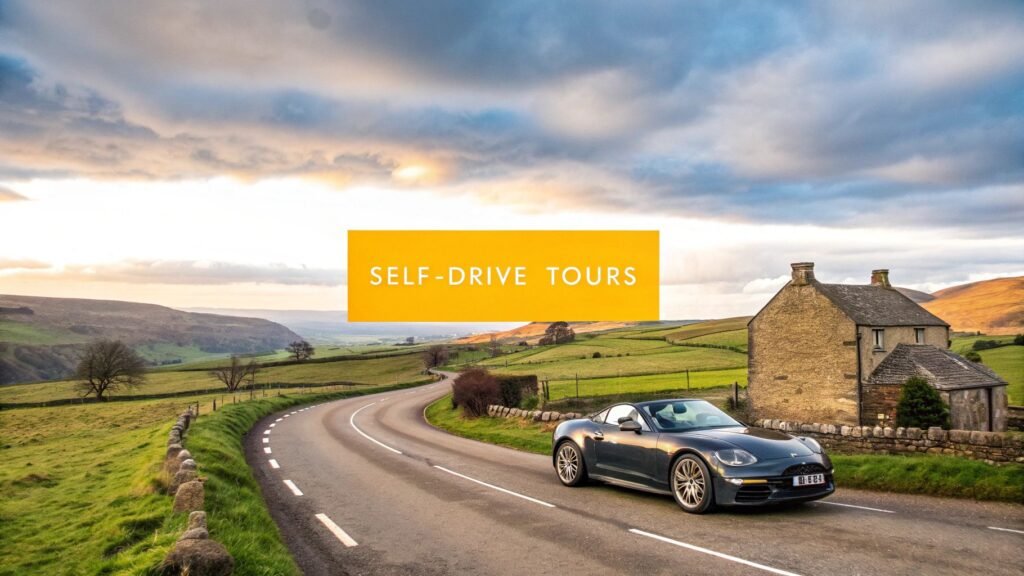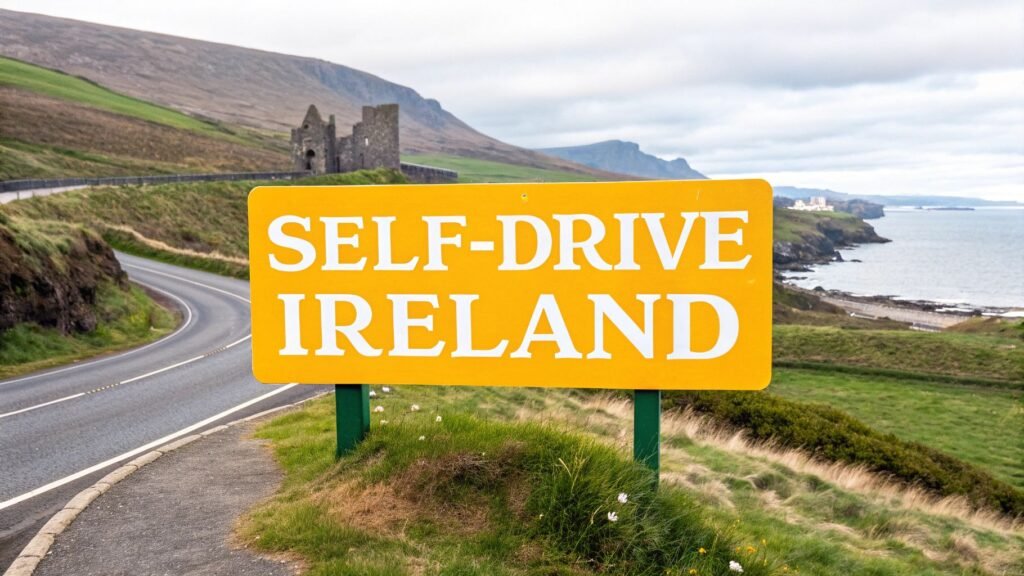Picture this: you’re behind the wheel, cruising along a winding road flanked by impossibly green fields, with the freedom to pull over whenever an ancient castle or a dramatic cliffside view calls to you. This is the magic of an Ireland road trip itinerary, and it’s by far the best way to soak in everything this island has to offer. This guide will be your trusted companion for that very adventure.
Crafting Your Perfect Irish Adventure
Hopping in a car and hitting the road is how you truly get to know Ireland. It’s not just about getting from Dublin to Galway; it’s about the unplanned detours, the tiny villages you stumble upon, and having the time to just stand and stare at a view that steals your breath. That kind of freedom is exactly why self-drive trips are the way to go.
Ireland is famous for its driving routes, and each one tells a different story. You could take on the legendary Wild Atlantic Way, a massive 2,600 km journey that traces the rugged, wild western coast. Or, you could head north for the Causeway Coastal Route, a path steeped in myth and jaw-dropping geology. Each route offers a completely different perspective on Ireland.
Visualising Your Journey
Sometimes, seeing the whole trip laid out helps it feel more real. This little snapshot gives you a high-level look at a classic driving loop around the island, covering the main stops, distance, and time.
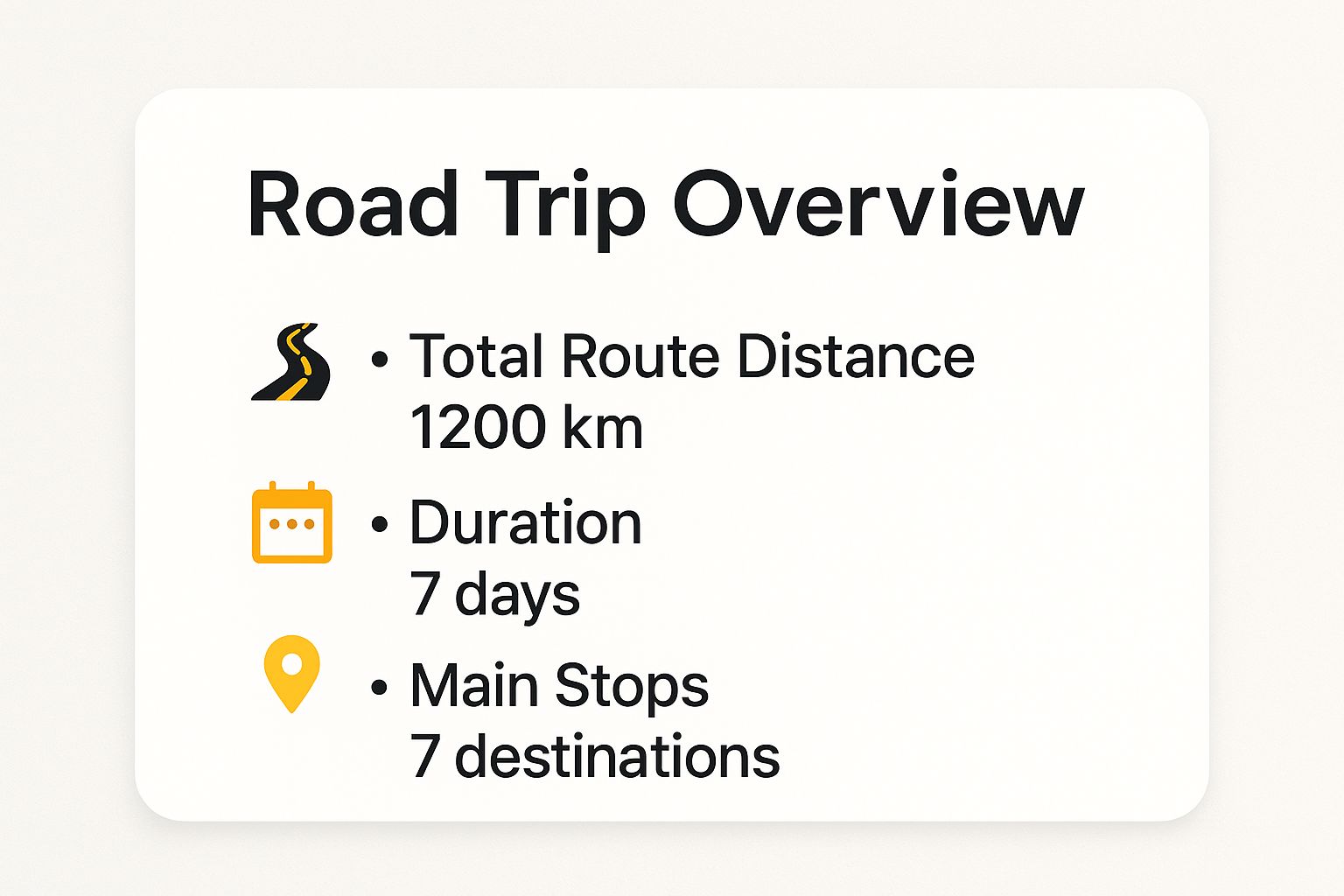
As you can see, you can pack a lot of incredible sights into a week without feeling rushed. The beauty of driving yourself is that you set the pace. It’s no wonder so many people choose this way to travel—tourism brings in about €6.2 billion to the Irish economy each year, and roughly 50% of those visitors are here for a holiday just like this. You can find out more about how travel shapes the Irish economy and see just how vital these trips are.
To give you a more concrete idea, here’s a look at how a classic 10-day trip might unfold.
Sample 10-Day Ireland Road Trip at a Glance
Planning a big trip can feel like a huge task, but breaking it down day by day makes it manageable. This table outlines a popular 10-day route that hits many of Ireland’s highlights. Think of it as a great starting point—you can follow it exactly or tweak it to build your own dream itinerary.
| Day | Route Section | Key Stops | Approx. Driving Time |
|---|---|---|---|
| 1-2 | Dublin & Ancient East | Dublin, Kilkenny | 1.5 hours |
| 3 | Southern Coast | Rock of Cashel, Cork | 2 hours |
| 4-5 | Wild Atlantic Way (South) | Kinsale, Ring of Kerry | 3-4 hours |
| 6 | Dingle Peninsula | Dingle, Slea Head Drive | 2 hours |
| 7 | Cliffs & The Burren | Cliffs of Moher, Doolin | 1.5 hours |
| 8-9 | Cultural Hubs | Galway, Clonmacnoise | 2.5 hours |
| 10 | Return to Dublin | Boyne Valley, Dublin | 2 hours |
This route gives you a fantastic mix of bustling city life, ancient history, and the wild, natural beauty Ireland is so famous for.
Days 1-3: The Ancient East and Southern Coast
Your grand Irish road trip begins the moment you wave goodbye to Dublin’s buzz and head south. The first few days will immerse you in a landscape steeped in stories stretching back over 5,000 years – a region they rightly call Ireland’s Ancient East. This isn’t just about getting from A to B; it’s about travelling through time itself.
Forget the motorways for a bit. You’ll soon find yourself on winding country lanes, framed by ancient stone walls and those iconic rolling green hills. This is the Ireland you’ve pictured. Having your own wheels means you can pull over whenever a stunning view catches your eye or a quaint village tempts you in.
Day 1: The Medieval Charms of Kilkenny
Once you leave Dublin, your first major destination is the medieval stronghold of Kilkenny. It’s a comfortable 1.5-hour drive, leaving you plenty of the day to explore. Find a place to park and set out on foot to discover the “Medieval Mile,” a fantastic trail connecting the majestic Kilkenny Castle with the towering St. Canice’s Cathedral.
The castle is unmissable, its formidable stone towers dominating the city’s skyline. A tour inside offers a fascinating look into centuries of aristocratic life. Afterwards, get wonderfully lost in the city’s narrow, winding alleyways—known locally as ‘slips’—which are brimming with artisan shops, traditional pubs, and cosy cafés perfect for a well-deserved break.
Day 2: The Rock of Cashel and on to Cork
Today’s drive takes you to one of Ireland’s most iconic and dramatic archaeological sites: the Rock of Cashel. This breathtaking cluster of medieval buildings sits atop a limestone hill, once the historic seat of the High Kings of Munster. The 13th-century Gothic cathedral and 12th-century Romanesque chapel are simply awe-inspiring.
Pro Tip: Try to visit the Rock of Cashel either first thing in the morning or later in the afternoon. You’ll miss the crush of tour buses and get to enjoy a much more personal and atmospheric connection with the ancient stones.
From Cashel, it’s an easy drive down to Cork, Ireland’s vibrant second city. Famous for its fiercely independent spirit and incredible food scene, Cork is a fantastic place to base yourself for the night. Make sure to wander through the English Market, a historic covered food hall that’s been operating since 1788, to feast your eyes on the incredible local produce.
Day 3: Blarney Castle and the Flavours of Kinsale
You can’t come to this part of Ireland without visiting Blarney Castle, located just a quick 20-minute drive from Cork. While most visitors line up to kiss the famous Blarney Stone for the “gift of the gab,” don’t make that your only stop. The castle grounds are truly magical, with hidden waterfalls, a curious poison garden, and woods filled with ancient yew trees.
After you’ve explored Blarney, point the car south to the stunning harbour town of Kinsale. Widely hailed as Ireland’s culinary capital, its cheerful, brightly painted streets are filled with world-class restaurants and delightful pubs. It’s the ideal spot to indulge in some incredibly fresh seafood while you reflect on the first leg of your incredible journey. This experience provides the perfect introduction before you continue your adventure west.
Days 4-6: Driving the Iconic Wild Atlantic Way
After the charming, almost gentle flavours of Kinsale, your road trip is about to shift gears dramatically. You’re now heading for the legendary Wild Atlantic Way, a route that hugs some of the most untamed and breathtaking coastal scenery on the planet. This is where the raw power of the Atlantic Ocean crashes against the Emerald Isle, creating a spectacle that feels truly ancient and alive.

The next three days are all about its most celebrated southern stretches. Forget just ticking off sights; this part of the journey is about immersing yourself in landscapes that have stirred the souls of poets and storytellers for centuries. We’ll be focusing on two jewels in Ireland’s crown: the world-famous Ring of Kerry and the fiercely beautiful Dingle Peninsula.
Day 4: Navigating the Ring of Kerry
The lively town of Killarney, right on the edge of the sprawling Killarney National Park, will be your base camp. From here, you’ll tackle the 179-kilometre (111-mile) Ring of Kerry. It’s arguably Ireland’s most famous driving loop, and you’ll quickly see why as it winds you through a panorama of rugged coastlines, golden beaches, and jaw-dropping mountain passes.
Here’s a pro tip: drive the ring counter-clockwise, starting from Killarney and heading towards Kenmare. This is the same direction tour buses are required to travel. It might sound counterintuitive, but it actually makes it much easier to pull over at scenic spots or safely pass them without meeting a behemoth on a tight corner.
Be sure to hit these essential stops:
- Moll’s Gap: A stunning mountain pass with sweeping views of the MacGillycuddy’s Reeks mountain range. The scale is just incredible.
- Ladies View: This viewpoint earned its name after Queen Victoria’s ladies-in-waiting visited in 1861 and were simply captivated by the scene. It’s that beautiful.
- Derrynane House: Wander through the ancestral home of Daniel O’Connell, one of Ireland’s most revered historical figures, which is set in gorgeous parklands right by the sea.
To really get under the skin of this region, our detailed guide offers more secrets on the Wild Atlantic Way in Ireland. It’s packed with tips for finding those hidden gems that make a trip truly unforgettable.
Day 5: Choosing Your Skellig Adventure
Today comes with a thrilling decision. You can either continue exploring the main Ring of Kerry, maybe taking a boat trip across the serene Killarney Lakes, or you can detour onto the wilder, less-travelled Skellig Ring. This side-loop peels off the main route and delivers a more raw and authentic coastal experience.
The Skellig Ring is your gateway to Portmagee, the launch point for what might just be Ireland’s most awe-inspiring excursion: a trip to Skellig Michael. This jagged, otherworldly island pinnacle, a UNESCO World Heritage site, was home to a community of monks from the 6th to the 12th century. Landing trips are like gold dust and must be booked months, sometimes even a year, in advance.
The immense draw of this region is a powerful economic engine. International visitors, many on road trips just like this, are vital. To put it in perspective, visitor spending in a single recent month hit €326 million. You can discover more insights on the impact of tourism from the CSO.
Day 6: The Magic of the Dingle Peninsula
A short drive north of Killarney takes you to the Dingle Peninsula, a place where Irish culture, language, and tradition feel incredibly vibrant and alive. Its heart is Dingle town, a colourful fishing port famous for its fantastic pubs and live traditional music. It’s a tiny place, home to only around 1,300 residents, but it boasts over 50 pubs—you do the math!
The absolute highlight here is the Slea Head Drive, a circular route that hugs the peninsula’s western tip. It’s narrower and, I’d argue, even more dramatic than the Ring of Kerry. You’ll find ancient beehive huts clinging to the hillsides, staggering cliff views, and the mythical Blasket Islands sitting just offshore.
My advice? Take it slow. Pull over often. Let the sheer, wild beauty of this place sink right into your bones. Spend the night in Dingle, find a pub with a crackling fire, and raise a glass to the perfect end to this leg of your Irish adventure.
Days 7-8: Conquering Cliffs and Cultural Hubs
As you push north along the Wild Atlantic Way, the landscape shifts again. You’re entering a part of Ireland where myths feel real, music spills from every pub, and the geology is nothing short of dramatic. The next two days are a journey into the soul of Ireland, from the staggering Cliffs of Moher to the bohemian heart of Galway.
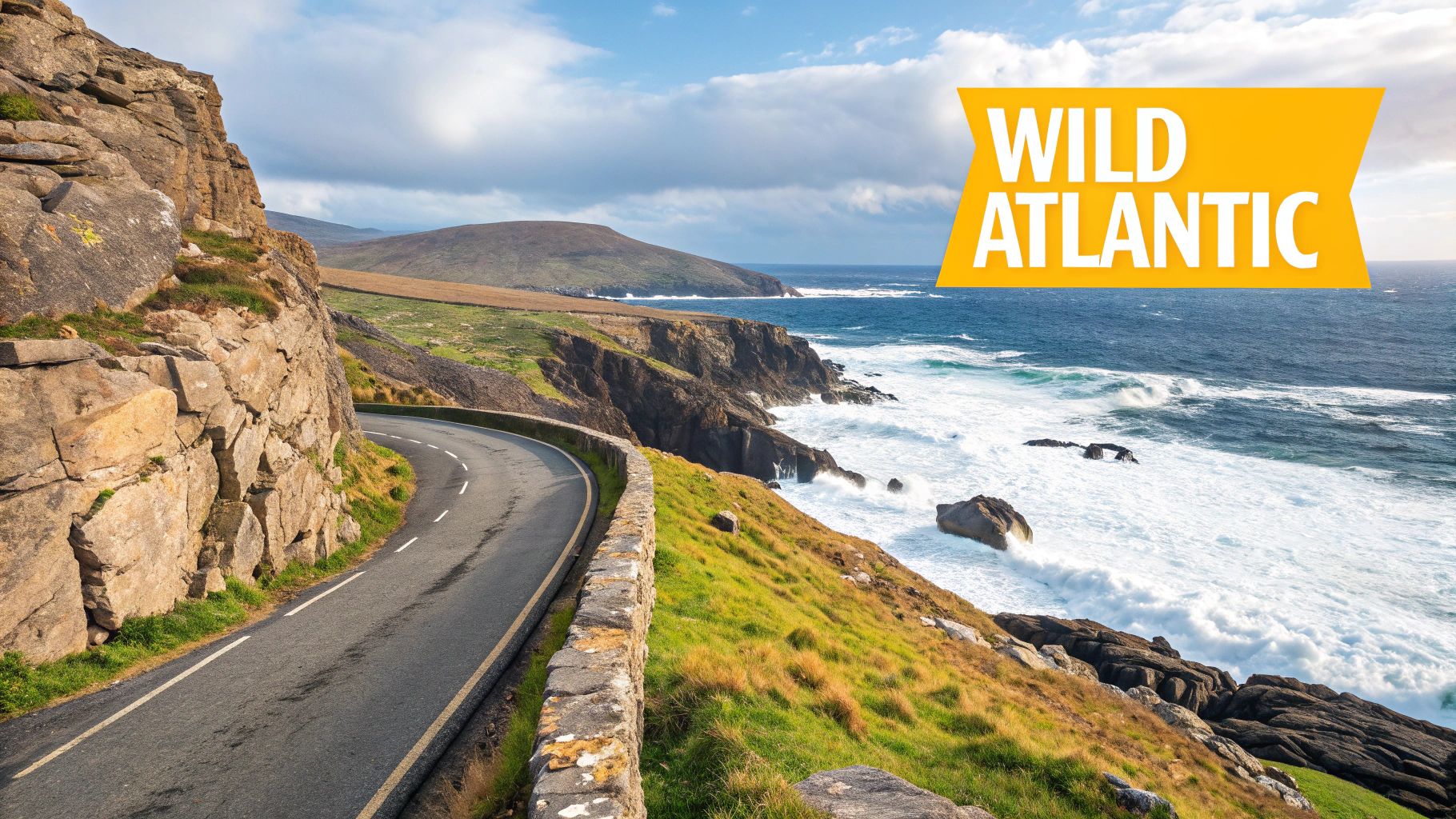
This leg of the trip is a study in contrasts. You’ll witness the raw, untamed power of the Atlantic coast before diving headfirst into a city that will sweep you off your feet with its vibrant, artistic energy.
Day 7: The Majestic Cliffs and Lunar Landscapes
Today is dedicated to two of Ireland’s most incredible natural wonders. First up, the legendary Cliffs of Moher. Pictures truly don’t do them justice. These giants rise 214 meters (702 feet) straight out of the churning Atlantic and stretch for a mind-boggling 14 kilometres.
The main visitor centre is well-run, but it gets absolutely packed. I’ve found a much better way to see them.
Insider Tip: To dodge the biggest crowds, skip the main entrance. Instead, drive just a kilometer south and look for a small car park run by a local farmer. For a few euros, you can park and join the coastal path from a much quieter spot, giving you a more personal and peaceful experience with the cliffs.
From this southern point, you can walk towards the main viewing areas. The views unfold spectacularly with every step, but you get to enjoy them without the initial bottleneck of tour buses. Be warned, the wind here is no joke—stick to the marked paths and stay well back from the unprotected edges.
After the cliffs, your drive takes you into a completely different world: the Burren National Park. It’s a surreal experience as the familiar green fields suddenly vanish, replaced by a vast, cracked pavement of limestone that looks more like the surface of the moon. This is a unique karst landscape, scoured by glaciers thousands of years ago. Look closely, and you’ll find a surprising mix of Arctic, Alpine, and even Mediterranean wildflowers thriving in the cracks.
The Burren is also dotted with ancient history. You absolutely have to stop at the Poulnabrone Dolmen, a portal tomb that dates all the way back to the Neolithic period (between 4200 BC and 2900 BC). Standing in front of this stone structure, which is older than the pyramids, you get a real sense of Ireland’s incredible historical depth.
Day 8: Arriving in Vibrant Galway
After a night in a village like Doolin, famous for its traditional music sessions, it’s a lovely, short drive up to Galway. If Ireland has a bohemian heart, this is it. Galway is a city where art, music, and a contagious zest for life fill the cobblestone streets.
Once you’re settled, make your way to Eyre Square, the city’s lively center. From there, it’s a straight shot down the main pedestrian street (which changes names as you go) into the famous Latin Quarter.
Mini-Guide to Galway’s Latin Quarter:
- Spanish Arch: This is what remains of the old city walls. It’s the perfect place to sit by the River Corrib and just soak it all in.
- Kirwan’s Lane: Get lost in this gorgeous, narrow medieval lane. It’s now filled with artisan shops, cool boutiques, and some of the city’s best restaurants.
- Live Music: You can’t come to Galway and not experience a “trad session.” Pubs like The Crane Bar and Tigh Coili are legendary for their nightly, foot-stomping traditional music.
Galway isn’t a city for rigid plans. It’s a place for wandering. Follow the sound of a fiddle down a side street, pop into a pub that looks interesting, and just let the city’s incredible energy carry you through an unforgettable evening.
Days 9-10: Discovering Ireland’s Historic Heartlands
It’s time to turn the car eastward. As the wild Atlantic coast shrinks in your rearview mirror, you’ll begin the final leg of your journey. This isn’t a mad dash back to Dublin, though. Instead, think of it as a slow, deliberate journey through Ireland’s historic heartlands—a region of lush green pastures, meandering rivers, and ancient secrets that many people miss in their rush between the coasts.
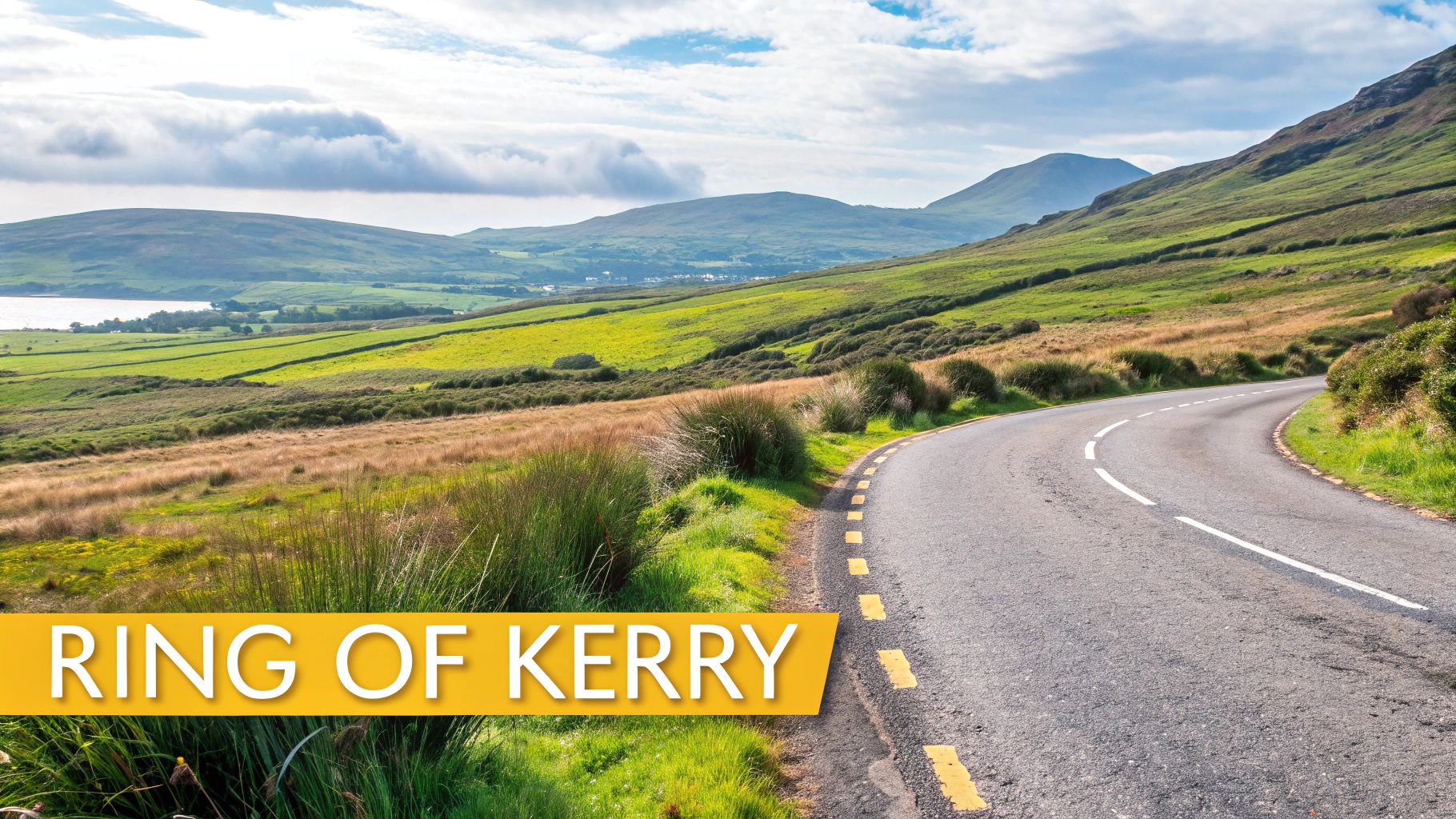
The drive from Galway is a pleasant change of scenery. You’re swapping the dramatic, rugged cliffs for the serene, rolling hills of the Irish midlands. The main destination for this part of the trip is one of the most sacred and important sites in the whole country, a place that just feels different, deeply spiritual and steeped in a palpable history.
Day 9: A Spiritual Journey to Clonmacnoise
Today’s absolute highlight is the ancient monastic city of Clonmacnoise, set beautifully on the banks of the mighty River Shannon. Founded way back in the 6th century by St. Ciarán, this was once a major European hub for religion, learning, and craftsmanship. Honestly, walking among its incredible collection of high crosses, round towers, and cathedral ruins feels like stepping back 1,500 years.
The three famous high crosses on the site are true masterpieces of early medieval art, their stone surfaces covered in intricate carvings of biblical scenes. To preserve them, the originals are now housed in the excellent visitor centre, with painstakingly created replicas standing in their original spots outside.
Clonmacnoise is so much more than a ruin; it’s a place of profound peace. Standing by the river, trying to imagine the Viking longboats that once sailed these very waters to raid the monastery, you get a powerful sense of its long and often turbulent history. It’s the perfect spot for some quiet reflection.
After soaking in all that ancient history, continue your drive toward the Dublin area. My advice? Instead of staying right in the busy city centre, consider booking your last night in a charming town on the outskirts, like Malahide or Howth. This gives you a peaceful end to your trip and makes for an easy drive to the airport if you’re flying out the next day.
Day 10: The Final Chapter and a Fond Farewell
Your last day is deliberately kept light, giving you time for a relaxed morning before you wrap up this incredible journey. If your flight schedule allows, you could spend a couple of hours exploring the magnificent grounds of Malahide Castle and its beautiful botanical gardens. It’s one last, perfect dose of Irish baronial splendour.
Of course, the final part of any great road trip is the celebratory meal. It’s that moment to raise a glass and talk about all the amazing things you’ve seen, from the wind-battered cliffs of the west coast to the ancient stones of the east.
Ideas for a Final Celebratory Dinner:
- A Classic Pub Meal: Find a cosy pub for one last perfect plate of fish and chips or a hearty Irish stew. It just feels right.
- Seafood in Howth: If you’re staying near the coast, the fishing village of Howth has fantastic seafood restaurants with lovely views over the harbour.
- City Centre Splurge: For a grand finale, head into Dublin for a gourmet meal in one of its acclaimed restaurants.
As you finish your meal, you’ll probably realise this trip wasn’t just about the places you visited. It was about the freedom of the open road, the friendly faces you met in tiny villages, and the countless memories you created along the way.
Your Guide to Driving in Ireland
A road trip is, without a doubt, the best way to soak up Ireland’s stunning landscapes. But let’s be honest, driving here is an adventure in itself. Think of this as a chat with a seasoned traveller, designed to get you comfortable behind the wheel so you can focus on the fun part.
The first thing to wrap your head around is driving on the left side of the road. If you’re from a country that drives on the right, this will feel odd for the first hour or two. My go-to trick? Just remember to keep your shoulder (the driver’s side) aligned with the centre line of the road. It won’t take long to feel natural, especially if you have a co-pilot gently reminding you which lane to be in after a turn.
Getting Your Rental Car and Insurance Sorted
When you go to rent a car, you’ll hear a lot about Collision Damage Waiver (CDW). Pay close attention here, because this is a big one. Many Irish rental companies won’t accept the insurance coverage from third-party sites or your credit card for CDW. This means you often have to buy their insurance directly. Always, always confirm this before you finalise your booking to avoid a nasty surprise at the rental counter.
Before you set off, giving the car a quick once-over is always a good idea. Even with a rental, a quick check of the tires and lights can set your mind at ease. If you’re new to vehicle checks, this an essential vehicle maintenance checklist that is a great resource. While spontaneity is great, a well-planned route takes the stress out of the equation. We’ve put together a number of expertly designed self-drive tours that let you see the best of Ireland without the hassle of planning.
Understanding Irish Roads and Signage
Ireland’s road system is a real mix. You’ll find modern ‘M’ roads (motorways) that get you between major cities quickly, but the real soul of an Irish road trip is found on the ‘N’ (national) and ‘L’ (local) roads. The L-roads are where the magic is—they’re often narrow, impossibly winding, and you’re far more likely to get stuck behind a flock of sheep than a traffic jam.
The secret to enjoying these tiny, charming roads is simple: slow down. There’s no prize for rushing. Pull over in the designated lay-bys to let faster local drivers pass, take a deep breath, and soak in the view. It’s not a race!
It’s reassuring to know that road safety is constantly improving. In the first four months of 2025, Ireland saw 54 road fatalities, which is a significant 18% reduction compared to the same period in 2024. These efforts make exploring the country’s beautiful, and sometimes tricky, roads much safer for everyone.
To help you get your bearings, here are a few of the most common signs you’ll see. Getting familiar with them now will make your drive that much smoother.
Understanding Common Irish Road Signs
| Sign Type | Description | What It Means for Drivers |
|---|---|---|
| Yield Sign | An inverted triangle with a red border. | You must give way to traffic on the main road you’re about to enter. Stop if necessary. |
| Yellow Diamond | A solid yellow diamond-shaped sign. | You’re on a major road and have the right-of-way at the next junction or series of junctions. |
| Speed Limits | Numbers inside a red circle, marked in km/h. | This is the absolute maximum speed. Remember, Ireland uses kilometres per hour, not miles. |
This table covers the basics, but the most important thing is to stay observant.
One last piece of advice from experience: always keep an eye on your fuel tank. When you’re heading into beautifully remote areas like the Dingle Peninsula or the quiet heartlands, petrol stations can be surprisingly far apart. Running out of fuel is one detour you want to skip on your Irish adventure.
Got Questions? We’ve Got Answers
It’s only natural to have a few questions swirling around as you piece together the perfect trip. Here are some quick answers to the most common things people ask when planning a self-drive adventure in Ireland.
What’s the Best Time of Year to Go?
Honestly, Ireland is beautiful anytime, but for the sweet spot between good weather and fewer people, you can’t beat the shoulder seasons. Aim for April-May or September-October. The days are still long, the landscapes are either bursting with spring colour or shifting into gorgeous autumn hues, and you won’t be jostling for space at every viewpoint.
Summer (June-August) is fantastic for warm weather, but it’s also peak season. That means bigger crowds and higher prices, so it’s a trade-off.
How Many Days Do I Need?
You can get a great taste of one specific region in 5 days, but to truly feel like you’ve seen Ireland, allow yourself 7 to 10 days. That’s the ideal amount of time to explore a good chunk of the island—like the Wild Atlantic Way and parts of Ireland’s Ancient East—without feeling like you’re constantly rushing from one spot to the next. It leaves room for those magical, unplanned detours.
Should I Get an Automatic or Manual Car?
This is a big one. The default and most common rental car in Ireland is a manual (stick shift). If you’re not 100% comfortable driving one, especially on narrow, winding roads, you absolutely must book an automatic well in advance.
They are much rarer and get snapped up quickly. You’ll also pay a bit more for an automatic, but trust me, it’s worth every penny for peace of mind if you’re not a seasoned manual driver.
A Word of Advice: Don’t just show up at the rental desk hoping for an automatic. It’s a gamble you’ll likely lose. Securing the right car type beforehand is probably one of the single most important things you can do to guarantee a stress-free drive.
Can I See Game of Thrones Filming Locations?
Absolutely! Ireland is a pilgrimage site for Game of Thrones fans. While most of the iconic spots are in Northern Ireland (which is an easy and fantastic add-on to your trip), they are well within reach.
- The Dark Hedges (County Antrim, NI): This is the legendary Kingsroad. It’s as atmospheric in real life as it is on screen.
- Castle Ward (County Down, NI): You’ll know it the second you see it—this is Winterfell.
If you’re a die-hard fan, consider a dedicated tour out of Dublin or Belfast. The guides are brilliant and share all sorts of behind-the-scenes stories.
Ready to stop dreaming and start driving? At BTOURS, we live and breathe this stuff. We craft unforgettable self-drive tours that let you discover the real Ireland, all at your own pace. Let’s find the perfect adventure for you.


